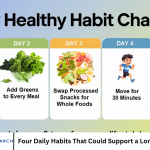In today’s fast-paced world, stress has become a near-constant presence in many people’s lives. Whether it stems from work pressures, financial struggles, family issues, or health concerns, chronic stress doesn’t just affect your mental state—it can also have physical consequences. One of the most common and visible impacts of prolonged stress is the accumulation of abdominal fat, often referred to as “cortisol belly.”
This article delves deep into what cortisol belly is, the hormonal mechanisms behind it, the symptoms to look out for, the causes that drive it, and the steps you can take to manage or prevent it. With research-backed insights and actionable tips, this comprehensive guide is essential reading for anyone struggling with stress-related weight gain.
What Is Cortisol?
Cortisol is a steroid hormone produced by the adrenal glands, located above the kidneys. It plays a crucial role in the body’s “fight-or-flight” response, regulating various processes including:
- Metabolism
- Blood sugar levels
- Blood pressure
- Inflammation
- Immune function
Cortisol levels naturally fluctuate throughout the day, peaking in the early morning and tapering off at night. However, chronic stress can keep cortisol levels elevated, leading to various health issues—including weight gain, especially around the midsection.
What Is Cortisol Belly?
“Cortisol belly” refers to the fat that accumulates in the abdominal area due to prolonged exposure to high levels of cortisol. Unlike subcutaneous fat (fat under the skin), cortisol belly typically involves visceral fat, which surrounds internal organs and poses greater health risks.
This condition isn’t just about vanity or body image—it’s a red flag for more serious metabolic imbalances and potential health complications.
Symptoms of Cortisol Belly
Recognizing the signs of cortisol belly can help with early intervention. Common symptoms may include:
- Increased abdominal fat that seems stubborn or disproportionate
- Persistent fatigue and low energy despite adequate sleep
- Frequent cravings, especially for sugary or salty foods
- Mood swings, anxiety, or depression
- Difficulty falling or staying asleep
- Elevated blood pressure readings
- Muscle weakness or reduced muscle tone
- Frequent colds or infections due to a weakened immune system
Causes of Cortisol Belly
Several factors can contribute to the development of cortisol belly. Understanding these can help you identify personal triggers and take corrective action.
Chronic Stress
The primary driver of elevated cortisol levels is long-term stress. When the brain perceives danger—whether real or psychological—it signals the adrenal glands to release cortisol. In modern life, this “danger” might be mental or emotional rather than physical, but the body responds the same way.
Poor Diet
Diets high in refined sugars, processed foods, and unhealthy fats can trigger inflammation and contribute to elevated cortisol. Irregular eating patterns or chronic dieting can also disrupt hormonal balance.
Lack of Sleep
Inadequate sleep affects the body’s ability to regulate cortisol rhythms, often keeping levels high when they should naturally fall. Chronic sleep issues are a major contributor to cortisol belly.
Sedentary Lifestyle
A lack of physical movement reduces the body’s ability to regulate hormones efficiently. Exercise is crucial for maintaining balance in the endocrine system.
Overtraining
Too much high-intensity exercise without adequate rest can backfire, raising cortisol instead of lowering it. A balanced workout routine is essential.
Alcohol and Caffeine
Excessive consumption of alcohol and caffeine can overstimulate the adrenal glands, leading to heightened cortisol levels, particularly when consumed late in the day or in large amounts.
Medical Conditions
Certain conditions can cause or contribute to elevated cortisol, such as:
- Cushing’s syndrome
- Polycystic ovary syndrome (PCOS)
- Thyroid imbalances
- Anxiety or depressive disorders
The Science Behind Cortisol and Fat Storage
When cortisol is released in response to stress, it increases blood sugar levels to provide quick energy for the body to respond. If the energy isn’t used—because the stress is mental rather than physical—the body stores that sugar as fat.
Cortisol also increases appetite, particularly cravings for high-calorie comfort foods. Over time, this leads to the accumulation of fat, especially in the abdominal region. As fat stores increase, the body can become desensitized to cortisol, requiring even more hormone production, creating a vicious cycle.
How to Diagnose Cortisol Belly
There’s no official medical test for cortisol belly, but it can be identified through a combination of factors:
- Personal and family health history
- Physical examination
- Saliva, urine, or blood cortisol tests
- Hormone panels to check related markers
- Body composition scans to measure visceral fat
- Waist circumference measurements
A waistline measuring over a certain threshold (commonly 40 inches for men or 35 inches for women) can be a sign of excess visceral fat and increased health risk.
Health Risks of Cortisol Belly
Visceral fat is more than a cosmetic concern. It can pose serious health risks, including:
- Increased risk of type 2 diabetes
- Cardiovascular disease and high blood pressure
- High cholesterol and triglycerides
- Non-alcoholic fatty liver disease
- Greater chance of stroke or heart attack
- Chronic inflammation
- Mental health disorders such as anxiety and depression
Treatments and Solutions for Cortisol Belly
Combating cortisol belly requires addressing the root cause—chronic stress—and rebalancing hormone levels through lifestyle and medical interventions.
Stress Management
Managing stress is critical. Helpful strategies include:
- Practicing mindfulness or meditation
- Deep breathing exercises and guided relaxation
- Cognitive behavioral therapy (CBT)
- Creative outlets like painting or writing
- Spending time outdoors or with loved ones
Nutrition
A balanced, anti-inflammatory diet supports hormone health. Focus on:
- Fresh vegetables and fruits
- Whole grains and legumes
- Lean protein sources like fish, poultry, tofu
- Healthy fats from nuts, seeds, and olive oil
- Avoiding sugar, processed foods, and refined carbs
Exercise
Physical activity helps lower cortisol and improve metabolism. Recommended routines include:
- Strength training for muscle development
- Gentle to moderate cardio like walking or swimming
- Flexibility and stress-reducing practices like yoga or tai chi
- Avoiding excessive intense cardio without recovery
Sleep Hygiene
Establishing regular sleep routines is essential. Tips include:
- Going to bed and waking up at consistent times
- Avoiding screens and caffeine before bedtime
- Using blackout curtains or white noise for better rest
- Creating a calming bedtime routine
Medical Intervention
In certain cases, professional medical care is needed. Treatment may involve:
- Addressing underlying hormonal or thyroid conditions
- Prescribing medication for anxiety or depression
- Hormonal therapies if needed under supervision
- Regular checkups to monitor cortisol levels
Supplements That May Help
Some natural supplements may aid in managing cortisol levels. These include:
- Magnesium for nervous system support
- Vitamin B complex for stress management
- Omega-3 fatty acids to reduce inflammation
- Ashwagandha and rhodiola for adrenal support
- L-theanine to promote calmness
- Probiotics to improve gut health
Frequently Asked Questions
What is the main cause of cortisol belly?
Cortisol belly is primarily caused by chronically high levels of the stress hormone cortisol. This is usually due to prolonged stress, poor sleep, unhealthy eating habits, and lack of physical activity. When cortisol stays elevated for too long, it promotes fat storage in the abdominal area.
Can you lose cortisol belly with diet alone?
Diet plays a crucial role, but it’s usually not enough on its own. While eating whole, nutrient-rich foods helps regulate blood sugar and lower inflammation, managing stress, improving sleep, and exercising regularly are equally important to reduce cortisol and burn visceral fat.
Is cortisol belly the same as regular belly fat?
No, cortisol belly specifically refers to visceral fat linked to elevated cortisol levels. It surrounds internal organs and increases the risk of serious health issues like heart disease, diabetes, and high blood pressure—making it more dangerous than subcutaneous fat, which lies just beneath the skin.
How long does it take to get rid of cortisol belly?
There is no exact timeline, as it depends on several factors such as stress levels, diet, exercise routine, and individual metabolism. With consistent lifestyle changes and stress management, visible improvements can begin within a few weeks to months.
Can medication help reduce cortisol belly?
In certain medical conditions like Cushing’s syndrome or severe hormonal imbalances, medication may be necessary. However, for most people, lifestyle changes are the first and most effective treatment. Always consult a healthcare provider before starting any treatment.
Does intermittent fasting help with cortisol belly?
Intermittent fasting can be beneficial for some individuals by improving insulin sensitivity and promoting fat loss. However, for people with chronic stress, fasting may spike cortisol levels further. It’s best to personalize your approach based on how your body responds.
Are men or women more prone to cortisol belly?
Both men and women can develop cortisol belly, but women may experience more fluctuations due to hormonal shifts during menopause, pregnancy, or menstrual cycles. Men, however, tend to store more visceral fat by default, putting them at higher risk.
Does drinking coffee increase cortisol?
Yes, caffeine can temporarily raise cortisol levels, especially when consumed in excess or on an empty stomach. If you’re sensitive to caffeine or under chronic stress, limiting your intake may help lower cortisol and reduce belly fat.
Conclusion
Cortisol belly is more than just an aesthetic concern—it’s a physical manifestation of chronic stress and hormonal imbalance that can seriously impact your health. While it may be frustrating and stubborn, the good news is that it’s entirely manageable with the right knowledge and strategies.






